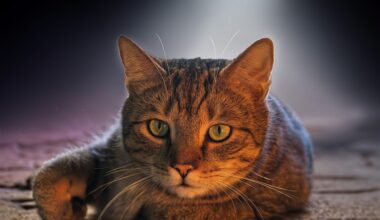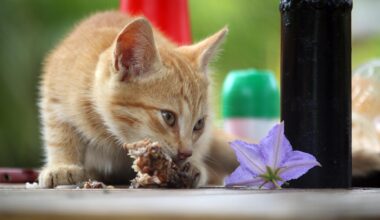Common Misconceptions About Cat Food Labels Debunked
When it comes to cat food labels, many misconceptions abound that can lead pet owners astray in understanding feline nutrition. One of the most common is that terms like ‘premium’ or ‘natural’ ensure the food is of higher quality. In reality, these labels don’t have standardized meanings and can be misleading. It’s crucial for cat parents to scrutinize ingredient lists and nutritional information instead of relying solely on marketing terms. Often, certain words are used to evoke an image of quality without actual evidence. For example, an ingredient termed ‘meat meal’ is often perceived negatively without understanding that it can be a concentrated source of protein. Understanding how to read labels not just helps in making informed choices but also empowers caregivers about their pet’s health. Moreover, being aware of fillers that add bulk without nutrition is vital. Making the right choices can profoundly impact your cat’s health and longevity. Therefore, take the time to research and understand what your feline family member really needs in their diet for optimum health and happiness.
Another misconception surrounding cat food labels is the belief that grain-free diets are inherently healthier for all cats. While some felines may have sensitivities to grains, many cats benefit from the nutrients found in whole grains. Therefore, it’s essential to evaluate your cat’s unique needs rather than jumping on the grain-free bandwagon due to popular trends. Nutritional requirements vary based on age, health, and activity level. Moreover, essential vitamins and minerals must be present in proper proportions. A balanced diet may include a combination of protein sources, vegetables, and grains for optimal health. Always consult a veterinarian when considering changes to your cat’s diet. It’s equally important to recognize that cleaning up a cat’s litter box can provide insights into their health. Issues like diarrhea or unusual habits may indicate dietary intakes that need adjusting. Good nutrition is key to a cat’s well-being, ensuring proper stool structure and overall health. Informed decisions based on credible information can help cat owners navigate the complexities surrounding feline nutrition labels, leading to healthier choices and happier pets.
Understanding Ingredients
Understanding the ingredients in your cat’s food is essential for making informed decisions. Many cat owners mistakenly assume that ingredients at the top of the list are always the best and most beneficial. However, what matters more than the order of ingredients is understanding what they actually are. For instance, an ingredient labeled ‘by-product’ can have different meanings and varying qualities, whereas a ‘named meat’ indicates a specific protein source. Reading the fine print can reveal a lot about the quality of food. Not all proteins are created equal, and some may come from less desirable sources that don’t offer the same nutritional benefits. Furthermore, the inclusion of artificial additives and preservatives can also negatively impact your cat’s health. As a result, you should look for products that use natural preservatives and minimal additives to promote a healthy diet. Additionally, pay attention to claims such as ‘complete and balanced’ per AAFCO guidelines, which indicates that the food meets the nutritional standards set for feline diets. These nuances in labeling can greatly influence your cat’s health.
The misconception that all wet cat food is inherently better than dry food needs clarification. Each type has its own set of advantages and disadvantages. Wet food can provide increased moisture, which is crucial for urinary health; however, it can also be more expensive and less convenient. On the other hand, dry food can serve as dental health support, with its crunchy texture contributing to reduced tartar buildup. It’s important to incorporate a balanced approach by potentially mixing wet and dry options in one’s feline’s diet. Storing dry food correctly is also essential to prevent spoilage and maintain its nutritional integrity. Moreover, avoiding bulk purchasing can reduce the risk of both container and food spoilage. The real goal should be to provide a well-rounded diet that considers your cat’s unique needs, lifestyle, and preferences. Offering a variety in flavors and textures can help keep them interested in meals and contribute to their overall health. Proper education and knowledge of both wet and dry foods will empower cat owners to make the best choices possible.
Nutritional Claims and Deception
Nutritional claims on cat food labels can often be a source of confusion for pet owners. Terms like ‘complete and balanced,’ ‘holistic,’ or ‘human-grade’ may suggest superior quality but often lack specific definitions. For instance, ‘holistic’ has no regulatory meaning and can be applied to foods that vary greatly in quality. Thus, while such claims might sound appealing, they should not be the sole basis for choosing a diet for your cat. Instead, check for the Association of American Feed Control Officials (AAFCO) statement regarding the nutritional adequacy of the food. This certification provides important reassurance that the product meets specific dietary guidelines. Evaluating marketing techniques critically allows you to differentiate between substance and hype. Being aware of the pet food industry’s tendency to prioritize appeal over nutritional value can keep your cat healthy. Consulting with a veterinarian can also help clarify what particular claim types actually mean in relation to your cat’s specific needs. Empowering yourself with knowledge translates to informed decisions about what you feed your feline friends.
Finally, a substantial misconception about cat food labels is the urgency to follow trends without considering individual needs. While some recipes may promise weight management or improved coat health, these need evaluation for your respective cat’s circumstances. Cats are intricately different, exhibiting varied preferences and nutritional needs. Relying solely on trends often neglects these critical differences. It’s advisable to consult with your veterinarian when considering any dietary changes or introductions, especially if your cat has specific health concerns or dietary restrictions. Reports about cat allergies or intolerances could arise from poorly suited ingredients. The focus should be on nutritionally balanced recipes tailored to the individual cat’s needs. Moreover, following a well-planned regular feeding schedule and monitoring your cat’s weight can help manage health effectively over time. Engaging quality foods alongside regular veterinary check-ups creates a strong foundation for your cat’s well-being. Prioritize unique preferences over popular trends for a sustainable approach to feline nutrition, promoting better health outcomes for your beloved furry companion throughout their lifespan.
Conclusion and Further Reading
Understanding feline nutrition labels thoroughly benefits not just the cats but their parents as well. Knowledge dispels myths and enables sharper judgment when choosing the best food options. Staying informed about the truths surrounding food labels empowers you to make choices based on nutrition, not marketing gimmicks. In the evolving landscape of pet food, understanding these critical nuances preserves the health and longevity of your feline companions. It’s also a good idea to keep researching reliable resources for guidelines on nutrition. Websites such as Cat Food Adviser provide a wealth of information regarding what cat owners should prioritize when selecting food. This process also fortifies the bond between a pet and its owner, ensuring a fulfilling and informed journey. Your cat deserves thoughtful care regarding their nutrition, leading to a happier, healthier life. Cats often rely on their people to make the right choices, so staying committed to learning can lead to long-lasting benefits in the feline community. Never hesitate to seek professional advice when in doubt about dietary choices. Happy feeding!
Choosing the right food for your feline friend can be daunting, but understanding labels helps simplify this journey. Misconceptions surrounding cat food labels can lead to poor dietary choices that might adversely affect our pets’ health. Knowledge of what goes into cat food means owners can make informed decisions, ultimately ensuring their cats receive proper nutrition and care. The task itself requires some vigilance and a degree of responsibility. Finally, knowing how each ingredient contributes to your feline companion’s well-being empowers you to keep them healthy and happy. Investing time into learning about cat nutrition pays off significantly in both the short and long term, allowing for a more fulfilling companionship. Don’t rely entirely on labeling but leverage it as a vital tool for understanding your cat’s nutritional needs. An informed approach paired with proper veterinary guidance is indispensable. As you navigate through food options, remember that making healthy choices translates to a happier and longer life for your cat, promoting a loving and enriching relationship that enhances both lives.


